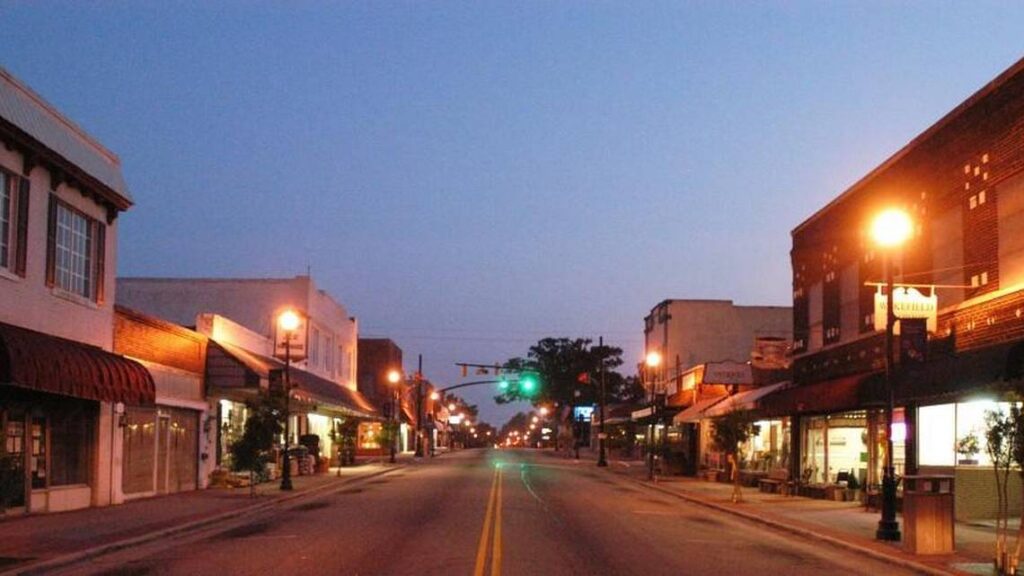HOA Management Services in Zebulon, NC
William Douglas Management is a leader in customer service — the experience and expertise that your association needs and deserves!
William Douglas Management Company ZEBULON NC
Zebulon, North Carolina, or the Town of Zebulon, is located in the easternmost part of Wake County. The city limits of Zebulon partially go into Johnston County and Nash County. Zebulon is 22 miles directly east of Raleigh, North Carolina, the capital. Zebulon is located just over three miles from where the four counties of Franklin, Johnston, Nash, and Wake intersect. The 2010 U.S. Census placed Zebulon’s population at 4,433. The U.S. Census 2019 population estimate for Zebulon was 5,917. The town motto is “The Town of Friendly People.”
The North Carolina General Assembly granted Zebulon a town charter in 1907. It was known and incorporated thereafter as the Town of Zebulon. Cities and towns over history develop for a number of reasons, proximity to navigable water, proximity to natural resources, etc. Zebulon is in existence because of the railroad, the Raleigh and Pamlico Sound Railroad Company.
Zebulon was named to honor Zebulon Baird Vance (May 13, 1830 – April 14, 1894) the 37th and 43rd Governor of North Carolina. Vance’s first term of governor was during the American Civil War. Vance, running under the Conservative Party which was made up of former Whigs and Democrats with Unionist leanings, overwhelmingly defeated Confederate secessionist Democrat William J. Johnston in September of 1862. Vance’s victory apparently reflected the views of most North Carolinians who were not necessarily for secession, but just reluctantly followed their neighboring states.
Vance served two initial terms as governor from September 8, 1962 to May 29, 1865. His condemnation of the severe military conscription practices of North Carolinians caused strained relations with the Confederate government in Richmond during much of his time in office. Vance testified at a hearing after the Civil War of Confederate General George Picket’s summary execution of twenty-two North Carolinians in Union uniforms at New Bern who Picket considered deserters. At great personal political risk Vance testified that the executed North Carolinians were “troops raised for local defense” and “the Confederate government did not keep faith with these local troops,” who were then “transferred to the regular service.” At least some of these executed men originally being local militia and being transferred to the regular Confederate army. Vance contented this transfer from local militia to the regular Confederate army was in “violation of their enlistment agreement.” As such, these twenty-two men should not have been hanged as deserters. Pickett fearing that he would be prosecuted for war crimes fled to Canada with his family.
With Union General William Tecumseh Sherman’s troops advancing on Raleigh from the south, Vance fled westward to Statesville, NC where, on May 13, 1865, he was eventually captured and arrested by Union troops. He was moved to a prison in Washington, D.C., and was paroled on July 6, 1865. While no charges were ever filed against him, Vance, on March 11, 1867, received a full pardon from the federal government.
Vance was elected by the North Carolina General Assembly to the United States Senate in 1870. However, he could not be seated in the Senate due to restrictions placed on people who had a prior relationship with the Confederate government. He was elected North Carolina Governor once again in 1876. The North Carolina General Assembly again elected him to the United States Senate in 1879. With the prior restrictions lifted, Vance served as Senator until his death in 1894.
After the Civil War, Vance became known nationally and internationally for a lecture he gave around the United States. The lecture, “The Scattered Nation,” discussed the Jewish people, and stressed understanding and tolerance of all people. It was a lecture on the universal brotherhood of man. This lecture has been bound into a booklet and is still in print today. For his time, he was one of the most progressive Southern political leaders and accomplished a great deal for the citizens of North Carolina. Zebulon Vance was in the classic sense a true statesman.
The Raleigh and Pamlico Sound Railroad Company was formed in 1903. In 1906, the Raleigh and Pamlico Sound Railroad laid a rail line south from Washington, NC to Bridgeton, NC (New Bern, NC). The Raleigh and Pamlico Sound Railroad Company began to lay rail in the area of what would become Zebulon in 1906 for a totally new line from Raleigh to Wilson. The town of Wakefield, NC was the only town in the area along this planned new rail line that was going to be constructed. Wakefield had been settled around 1820 as a stagecoach stop on the Tarboro Road. It received a charter from the North Carolina General Assembly in 1899.

When the Raleigh and Pamlico Sound Railroad Company proposed constructing their rail line through Wakefield some of the citizens supported their effort. Some of the citizenry offered financial incentives to the railroad to help entice their selection of Wakefield. However, others in Wakefield objected to the rail lines being run through their town. Primarily citing the issues associated with trains, such as noise and pollution, as the reason Wakefield’s city leaders turned turn the proposition from the railroad.
Because of the railroad, Zebulon grew rapidly in the 1900s and 1910s. As Zebulon prospered, Wakefield became a victim of its political leader’s shortsightedness, and drastically declined as many of its citizens moved to Zebulon for work. The General Assembly repealed Wakefield’s town charter in 1913, and Wakefield was annexed into Zebulon in 1997.
With Wakefield removed from consideration, the Raleigh and Pamlico Sound Railroad brought the rail line south of Wakefield through the Whitley farm and the Horton farm in what was known then as Piney Forest. There were two railway construction crews, one beginning in Raleigh and the other beginning in Wilson working to meet in the middle. Temporary prison camps were constructed along the rail line route to allow for housing the prisoners who were clearing the right-of-way. Local laborers and several hundred Italian immigrants from Philadelphia constructed the rail line itself.
The Norfolk and Southern Railway acquired the Raleigh and Pamlico Railroad in 1906. Zebulon was incorporated in 1907. That same year, Avon G. Kemp’s general store established the first post office in Zebulon. In 1909. the railroad built a depot to handle passengers and freight. During this time frame, the first five years of the town, commercial buildings were being constructed en masse in downtown Zebulon. Reportedly, there were at least ten general stores after the town was chartered, within five years, that number had doubled. There were three blacksmith shops along with three stables. In 1907, the Whitley Hotel opened on the corner of N. Arendell Avenue and E. Horton Street, and within three years, four more hotels and boarding houses were open for business.
Edgar B. Barbee and Falconer B. Arendell formed the Zebulon Land Company in 1906 to develop the area which was to become the town of Zebulon. These land developers purchased 49 acres from the Whitley family and 41 acres from the Horton family. This land laid north of the Raleigh and Pamlico Sound Railroad Company rail line. They then laid these 90 acres out in a grid of typical city blocks, dividing the blocks into individual lots. The streets were established in the traditional method found in most all towns. Street names came from the original landowners, Zebulon’s first board of commissioners, and the developer’s own names.
Through the years the Zebulon board of commissioners prohibited the sale and consumption of alcohol within the town limits with the exception of “hop brew.” They only allowed pool halls to remain open until to 11:30 PM. In 1920, to preserve “good morals,” the board passed an ordinance prohibiting public dancing.
After the initial development of the railroad and associated enterprises, the largest economic driver for the next seventy years became more prevalent in Zebulon. This was the cultivation of the bright leaf tobacco and the formation of a tobacco market in town. The nearby sandy soil of the area for cultivation and the tobacco warehouses made Zebulon an important market. The first tobacco warehouse, Zebulon Warehouse, opened in 1907. In that same year another warehouse was opened by Martha Horton. In 1908, over 765,000 pounds of tobacco in total was moved through both warehouses. Eventually three more warehouses opened, Wiggs, Center Brick, and Farmers. Together by the 1920s, all five warehouses moved over 4,775,500 pounds of tobacco. Eventually, textile manufacturing and related enterprises opened in Zebulon. Manufacturing hosiery, ginning cotton, and cotton seed oil to name just a few.
As with almost all southern towns there are a wide array of housing styles represented. Towns along the coast probably have the widest array simply because of the earlier establishment of these communities. Even with the relatively recent founding of Zebulon, there are many great early residential architecture examples to see that have survived to present day. The older southern district of town has a number of highly ornamental large Queen Anne homes to see. Colonial Revival is well represented in the southern district. Representing the era of the town’s founding, Craftsman style homes are very representative. In town there is one home representative of the Italian Renaissance style. There is also a home representative of Georgian Revival. Gannon Avenue is the best street to drive to see these home styles in town.
As indicated by the U.S. Census, Zebulon’s population from the 1910 Census of 482 to the 2010 Census of 4,433, population growth was slow and steady in that 100 years. As compared to the 2010 Census to the 2019’s estimated population of 5,917 indicated the population growth rate of 33.5%.
Historical population
Census Pop. %±
1910 482 —
1920 953 97.7%
1930 860 −9.8%
1990 3,173 54.4%
2000 4,046 27.5%
2010 4,433 9.6%
1970 1,839 19.9%
1980 2,055 11.7%
Highways & Roads
Highways & Roads
1960 1,534 11.3%
2019 (est.) 5,917 [3] 33.5%
1940 1,070 24.4%
1950 1,378 28.8%
U.S. Highway 64 and U.S. Highway 264 are just north of Zebulon
U.S. Interstate 95 and U.S. Interstate 40 is easily accessible from Zebulon
Public transportation
Zebulon is served by the Triangle Transit Authority and this connects their commuters to the Raleigh, Durham, and Chapel Hill bus systems.
Rail Service
Amtrak does not offer direct passenger service through Zebulon; Amtrak does have regularly scheduled stops in Raleigh and Selma, NC
For Zebulon, Raleigh-Durham International Airport (RDU) is the most convenient airport. The following airlines currently serve Raleigh-Durham: Air Canada Express, Alaska Airlines, Allegiant Air, American Airlines, American Eagle, Delta Air Lines, Delta Connection, Frontier Airlines, JetBlue, Southwest Airlines, Spirit Airlines, Sun Country Airlines, United Airlines, and United Express.
The Zebulon schools are part of Wake County Schools System and are well rated from primary to secondary.
Need Association Management?
Contact Us
How to Start
The Process of Working With Us


REQUEST A PROPOSAL
Request a proposal online or call us directly.


WE WILL REVIEW YOUR CASE
Our team of highly trained professionals will review your case.


RECEIVE A CUSTOM TAILORED PLAN
We will create a customized management plan for your community.


SEAMLESS TRANSITION
We will implement a seamless management transition and integrate our tech.


SIT BACK & RELAX
Enjoy better, affordable and a more reliable, hassle-free management system.




